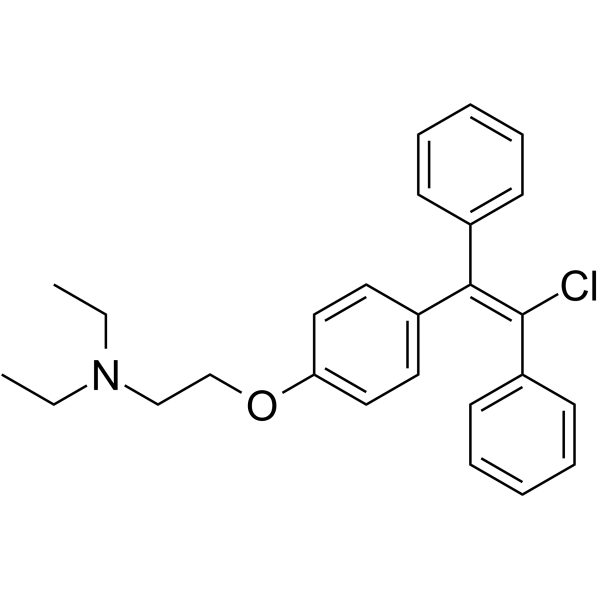enclomifene
Modify Date: 2025-09-04 09:04:10

enclomifene structure
|
Common Name | enclomifene | ||
|---|---|---|---|---|
| CAS Number | 15690-57-0 | Molecular Weight | 405.960 | |
| Density | 1.1±0.1 g/cm3 | Boiling Point | 509.0±50.0 °C at 760 mmHg | |
| Molecular Formula | C26H28ClNO | Melting Point | N/A | |
| MSDS | N/A | Flash Point | 261.6±30.1 °C | |
Use of enclomifeneEnclomiphene ((E)-Clomiphene) is a potent and orally active non-steroidal estrogen receptor antagonist, with antioestrogenic property. Enclomiphene can be used for the research of ovarian dysfunction, testosterone deficiency, male hypogonadism and type 2 diabetes[1]. |
| Name | trans-clomiphene |
|---|---|
| Synonym | More Synonyms |
| Description | Enclomiphene ((E)-Clomiphene) is a potent and orally active non-steroidal estrogen receptor antagonist, with antioestrogenic property. Enclomiphene can be used for the research of ovarian dysfunction, testosterone deficiency, male hypogonadism and type 2 diabetes[1]. |
|---|---|
| Related Catalog | |
| In Vitro | Enclomiphene (0-100 μM, 6 h) dose-dependently inhibits basal and gonadotrophin-stimulated small and large ovine luteal cell progesterone secretion[2]. Enclomiphene (0-100 μg/mL, 24 h) dose-dependently inhibits fertilization rates, blastocyst formation rates, and degeneration rates in mouse oocytes[3]. Enclomiphene (1 nM-10 μM, 6 h) dose-dependently decreases E2-induced inhibition of follicle stimulating hormone (FSH) secretion in primary sheep pituitary cells[4]. |
| In Vivo | Enclomiphene (subcutaneous injection, 0.25 and 0.5 mg/animal, daily) inhibits spermatogenesis and decreases serum luteinizing hormone (LH) and testosterone levels in intact or castrated rats[5]. Enclomiphene (oral adminstration, 0.03-3 mg/kg, daily for 90 days) reductes body weight to sham levels, and reduced serum cholesterol[6]. Animal Model: 21 days-old Charles River male rats[5] Dosage: 0.25 and 0.5 mg/animal, daily for 24 days. Administration: Subcutaneous injection Result: Decreased LH and testosterone levels in the serum. Animal Model: OVX (ovariectomy) rat model[6] Dosage: 0.03, 1, and 3 mg/kg, daily for 90 days. Administration: Oral adminstration Result: Reducted body weight to sham levels, and reduced serum cholesterol. Showed dose-dependent effects on the proximal tibia with BMD and BMC approaching posttreatment Sham levels. |
| References |
| Density | 1.1±0.1 g/cm3 |
|---|---|
| Boiling Point | 509.0±50.0 °C at 760 mmHg |
| Molecular Formula | C26H28ClNO |
| Molecular Weight | 405.960 |
| Flash Point | 261.6±30.1 °C |
| Exact Mass | 405.185944 |
| PSA | 12.47000 |
| LogP | 8.01 |
| Vapour Pressure | 0.0±1.3 mmHg at 25°C |
| Index of Refraction | 1.588 |
CHEMICAL IDENTIFICATION
HEALTH HAZARD DATAACUTE TOXICITY DATA
|
| 2-(4-(2-Chloro-1,2-diphenylvinyl)phenoxy)-N,N-diethylethanamine |
| Clomiphene |
| Zuclomiphene |
| Isomer A |
| Transclomifenum |
| 2-(4-(2-chloro-1,2-diphenylethenyl)phenoxy)-N,N-diethylethanamine |
| zuclomifene |
| Ethanamine, 2-(4-(2-chloro-1,2-diphenylethenyl)phenoxy)-N,N-diethyl- |
| cis-clomifene |
| 2-[4-(2-chloro-1,2-diphenylethenyl)phenoxy]-N,N-diethylethanamine |
| cis-clomiphene |
| enclomiphene |
| Ethanamine, 2-[4-[(E)-2-chloro-1,2-diphenylethenyl]phenoxy]-N,N-diethyl- |
| Transclomiphene |
| 1-[p-(b-Diethylaminoethoxy)phenyl]-1,2-diphenylchloroethylene |
| Clomiphene B |
| trans-Clomiphene |
| (E)-Clomiphene |
| 2-[p-(2-Chloro-1,2-diphenylvinyl)phenoxy]triethylamine |
| (E)-2-(4-(2-Chloro-1,2-diphenylethenyl)phenoxy)-N,N-diethylethanamine |
| trans-Clomifene |
| 2-[p-(b-Chloro-a-phenylstyryl)phenoxy]triethylamine |
| Z-CloMiphene-d4 |
| 2-{4-[(E)-2-Chloro-1,2-diphenylvinyl]phenoxy}-N,N-diethylethanamine |
| 2-{4-[(E)-2-chloro-1,2-diphenylethenyl]phenoxy}-N,N-diethylethanamine |